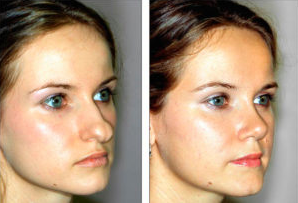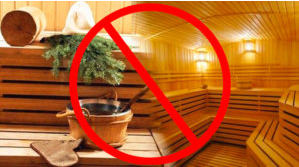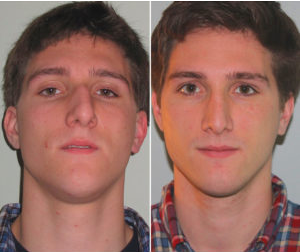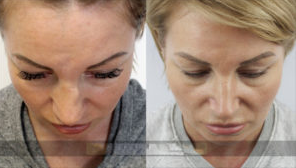
Rhinoplasty (or the nose) is used equally efficient, both for men and women, children – the reshaping of the nose in patients of younger age is only in the testimony of the doctors when in adults can be performed on your desire for a beautiful shape of nose.
Indications for rhinoplasty
- Too long nose.
- Pronounced hump.
- Large nose.
- Saddle nose shape.
- Pointed out/thickened nose.
- Asymmetric nostrils.
- Bent/"eagle" nose.
- Too big or small nose (imbalance).
- Deformation due to trauma, not surgery.
- Congenital defects in the fabric.
- Upturned.
- The bulge in front of the tip of the nose.
- The witness (for respiratory disorders).
- Deviation of the septum.
- Burn/freeze.
- Of the fracture.
Contraindications for rhinoplasty of the nose
Rhinoplasty cannot be carried out in any case when the following contraindications:
- Diseases of the blood vessels and the heart.
- Diseases of the liver.
- Bronchial asthma.
- The cardiac insufficiency.
- Diabetes.
- Oncology.
- Problems with the clotting of the blood.
- Mental disorders.
- Are allergic to medicines, which are used as a pain reliever.
- Immunodeficiency and disease, that are their "companions".
- Serious illness of an infectious nature.

Relative contraindications to rhinoplasty
- Age (18-20 years) – is because of the growth of cartilage and a high probability of change.
- Age 45+ — to the question of how the desired rhinoplasty is solved individually for each person.
- Pregnancy and lactation– in this case, therefore, it would be better if the interference is moved to another appropriate time.
- Critical days in women.
- Diseases of the respiratory nature.
The rehabilitation period after plastic nose
Rhinoplasty, like any other surgical intervention, which logically brings us to the question that after the surgery that will take time to recover.
This period depends on what was the volume of fixes, but the stay in the clinic or hospital is not necessary – the next day the patient can go home safely.
If the object of influence is only of cartilage, the recovery can vary from 7 to 10 days. But the surgery involves other departments as a consequence of the rehabilitation of approximately 14 days.
Rhinoplasty nose requires compliance with the recommendations of the experts:

- The use of a latch. Plaster of retention, splint or collodion adhesive. Really need to take it to 5-6 days, together with tires and other materials. It is necessary to fix the desired shape and effective alignment or correction.
- The treatment of the nasal passages. It is best to visit a doctor, but some of the recommendations on administration of medicines and the use of external tools necessary to perform independently.
- Follow the recommendations of your surgeon. Do not visit bathhouses, saunas, beaches, and do not wear sunglasses (this is permissible after a couple of months), and to limit bending and other physical activities.
Type of correction of the shape of the nose
Rhinoplasty tip of nose
This procedure will help to correct the nose, adjust the size, to eliminate the displacement of the center of the shaft and the tip of the nose.
Normally, when this type of manipulation to make incisions inside the nose, then removed a part of the fabric and give them some form, the imposition of certain joints. This is a very complicated procedure that requires some skill, but the result is an incredible transformation of the appearance.
The rhinoplasty of the nose
Rhinoplasty, where the price depends on the type of surgery and the amount of work performed, and in operations of the nose – helps to correct the hump, to remove the "indents" or even curvature to extend or make a new one already.
The solution is very important to create an aesthetically beautiful nose and is done through open or restricted access, with implants and other methods at the request of the customer.

Septoplasty
The intervention to correct the deviation of the nasal septum.
It is not only important in terms of addressing the cosmetic defect, but also facilitates nasal breathing.
ENT surgery
There are those ENT diseases which are cured only by surgical intervention. Usually, the main objective of the intervention is the removal of hematomas, cysts, polyps and other growths in the tissues of the body that deletes the contents of the maxillary sinus with inflammatory infectious diseases. In the majority of cases, this type of interference is carried out according to the policy of the MLA.
The use of the high quality of the equipment, the tools and painkillers allows interference of different complexities without pain and make rehabilitation less.
Revision rhinoplasty of the nose
Secondary correction is necessary if the main result was satisfactory.
Before you decide where you will fix the nose, it is necessary to consider several important factors is requires great skill of the specialist, in order to correct the consequences much more difficult than making something new from the raw data.
This procedure differs from the usual great complexity.
Otherwise it is the same pre-consultation with the doctor, the preparation and the implementation of the recommendations of the doctor during the rehabilitation.
The price may be different, depending on the degree of complexity, that is to say, surgical intervention may become an expensive hobby, or cheap service.

Post-traumatic rhinoplasty
Correction reconstructive of nature is a type of surgery that is widely used in those who have suffered various injuries. Rhinoplasty gives enormous opportunities to restore the anatomical characteristics of the nose. Recovery can occur with the transplantation of its tissue – integration of cartilage with the ear (without breaking form). The use of additional methods discussed individually with the doctor.
The type of access
Open rhinoplasty
This means that the incision is made not only inside, but also in the membrane between the nose and the presence of the outside seam.
The doctor can work directly with the fabrics due to the fact that you have full access. This is very important when you need other diagnostics, for example, when conducting secondary interventions to assess the general condition of the scar tissue. In addition, this method allows the processing time of vessels to avoid bleeding.
Closed rhinoplasty
This method involves carrying out an incision inside the nose, so that the skin and the integrity will not be infringed. This positively affects the appearance of the patient. In addition, the solution only lasts an hour or two. Rehabilitation with this method will also be shorter, which makes it easier to get in shape and to evaluate the result.
But for this kind of interference, a doctor must have a lot of experience and high qualification, as this method is much more complicated.




















